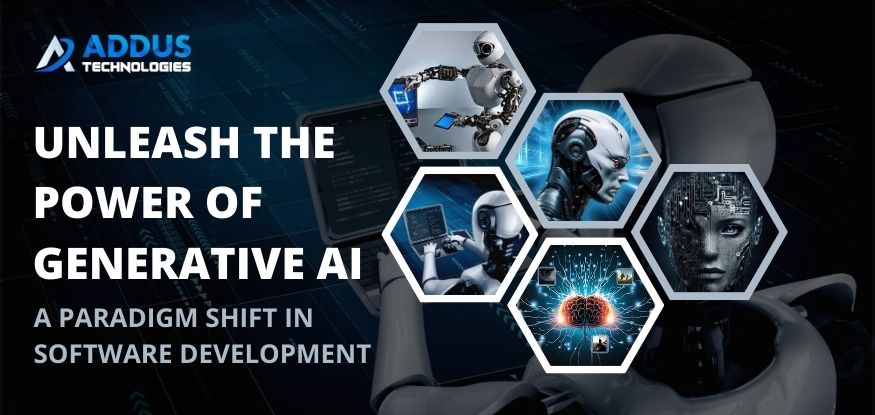Unleash the Power of Generative AI: A Paradigm Shift in Software Development

OpenAI’s latest release, ChatGPT, has garnered widespread attention for its versatility beyond traditional natural language processing tasks. Beyond language-related functions like translation and summarization, ChatGPT is being explored for creating innovative search engine architectures, explaining intricate algorithms, developing personalized therapy bots, aiding in AI app development, elucidating scientific concepts, crafting recipes, and even assisting in writing college essays.
Moreover, text-to-image programs like Midjourney, DALL-E, and Stable Diffusion are poised to revolutionize creative industries such as art, animation, gaming, movies, and architecture. Generative AI is seen as a transformative force in complex fields like computer engineering. Notably, GitHub Copilot, based on OpenAI’s Codex model, is helping developers by suggesting and autocompleting code, significantly enhancing their productivity with claims of up to 40% code autocompletion. The optimistic outlook is that generative AI will foster a new era of collaboration between humans and machines, expediting ideation and the overall creation process in various domains. Let me explain about Generative AI on software development in the blog below.
Understanding Generative AI Development
Generative AI development employs various approaches, with the prevalent method relying on machine learning algorithms like neural networks. This involves training a model on a substantial dataset, enabling it to produce novel outputs when given a prompt or seed input. An alternative approach utilizes evolutionary algorithms, mimicking natural selection to iteratively create enhanced solutions for a given problem. In the realm of generative AI, these algorithms can generate fresh content through the combination and mutation of existing data. These distinct methodologies showcase the diverse strategies employed in advancing generative AI technologies.
Revolutionizing Creativity Through AI
Gen AI tools, equipped with natural language capabilities, significantly enhance the productivity of creative professionals, saving them precious time and effort in generating new ideas or content. Our partnership with Vibrant exemplifies the transformative synergy of AI and human creativity, reshaping creative processes. Utilizing Dall-E3, Midjourney, and Runway ML has proven invaluable for crafting both static and dynamic images. Through detailed prompts, our team captures every aspect, from subject matter and style to composition, theme, mood, and context, including specific elements like lighting, dimensions, and perspective. Runway ML plays a crucial role in tasks such as image enlargement, improving low-resolution images, and transforming written prompts or static images into animated videos.
In the realm of brand building, achieving true authenticity involves delving deep into core beliefs and values, and transcending mere authenticity to establish trust with the target audience. While this process is typically time-intensive, AI offers an efficient means of crafting a robust brand strategy. By automating time-consuming tasks, designers can devote their energy to delivering precisely what they are most passionate about – creative brand narratives.
Influence of AI on Software Development
Artificial Intelligence is a game-changer, transforming industries. Explore its profound impact on coding and how it revolutionizes traditional software development processes.
Automated Code Generation
Generative AI has streamlined software development with automated code generation. Using machine learning algorithms to analyze code patterns, developers create efficient, error-free snippets, expediting the process and improving software quality.
Enhanced Bug Detection And Debugging
AI enhances the efficiency of debugging in software development. Advanced algorithms can identify and fix bugs in real time, reducing the reliance on manual intervention. This accelerates development and ensures reliable software.
Optimized Project Management
AI-driven project management tools enhance software development team efficiency by analyzing historical data, team performance, and external factors to predict roadblocks, optimize timelines, and deliver projects faster through improved resource allocation and task prioritization.
Personalized User Experiences
AI empowers software to offer personalized user experiences by adapting to behavior, preferences, and feedback through data analysis. This enhances satisfaction and provides developers with valuable insights for ongoing improvement.
Facilitating Collaboration
AI-driven tools simplify collaborative coding, enabling real-time cooperation among developers. With AI-enhanced version control systems, code changes integrate seamlessly, minimizing conflicts and promoting a more cohesive development process.
Predictive Maintenance
AI transforms software maintenance with predictive capabilities. By analyzing usage patterns and performance metrics, AI anticipates and addresses potential issues before escalation, minimizing downtime and ensuring a smoother user experience.
Security Augmentation
In addressing the security challenges of complex modern software, AI plays a key role. Machine learning algorithms can detect and neutralize potential security vulnerabilities, providing an extra layer of protection for safeguarding sensitive data.
Generative AI workflow
Generative AI, a facet of machine learning, operates by training software on extensive datasets, enabling predictions without extensive manual programming. Training these models involves providing substantial existing content, where probability distributions are employed to discern underlying patterns within datasets. When prompted, the models strive to generate patterns akin to the training data. Utilizing neural networks, generative AI identifies intricate patterns and structures in the data, surpassing the capability of traditional machine learning to handle more complex patterns. This approach marks a departure from traditional programming paradigms, as generative AI leverages learned knowledge from diverse datasets to autonomously generate content, making it a powerful tool for tasks like text and image creation, where creative outputs are required without explicit programming instructions.
Categories of Generative AI
Various generative AI models are designed to create fresh data, spanning images, text, music, and other forms of creative content.
1. Generative Adversarial Networks(GANs)
In this machine learning model, two neural networks, namely the generator and discriminator, engage in a competitive process to enhance accuracy in predictions. The generator’s task is to produce new instances, while discriminators aim to distinguish between artificial and real ones.
2. Recurrent Neural Networks(RNN)
RNNs, a neural network variety, are specifically crafted for processing sequential data. Their application extends to creative endeavors such as text generation, showcasing their effectiveness in handling tasks that involve a sequence of information.
3. Variational Autoencoders(VAEs)
Variational Autoencoders (VAEs) aim to maximize the likelihood of generating original data from latent spaces. They accomplish this by initially encoding input data into lower-dimensional spaces and subsequently decoding it to generate new data samples when needed.
Use Case of Generative AI in Industry
1. Finance
In the financial sector, Generative AI is leveraged to generate synthetic financial data closely mirroring real-world scenarios. This fabricated dataset is instrumental in training machine learning models, enhancing their accuracy and enabling more precise predictions. The automation of machine learning tasks and financial processes, including data analysis and fraud detection, minimizes human errors, streamlines time complexity, and optimizes resource utilization.
2. Healthcare Industry
Generative AI emerges as a valuable asset in the Healthcare sector, excelling in the creation of novel data. It produces high-resolution medical images like CT scans, X-rays, and MRI scans. These synthetic images and actual patient data contribute to training deep-learning models for image analysis and diagnosis. Additionally, it facilitates drug discovery by generating molecular structures for potential drugs and creates interactive healthcare chatbots for patient interaction.
3. Gaming Industry
Generative AI proves invaluable in the gaming industry by aiding in the design of 3D visuals and creating expansive, diverse game worlds through procedural content generation. It extends its capabilities to crafting animations, and characters, and generating voice and sound effects for both characters and gaming environments.
4. E-Commerce
In the e-commerce domain, Generative AI becomes instrumental in elevating online shopping experiences, optimizing operations, and boosting customer engagement. It effectively analyzes customer purchase history, preferences, and behaviors, providing enhanced product recommendations. This application underscores its potential to refine the e-commerce landscape for improved user satisfaction and operational efficiency.
5. Advertising
In the advertising realm, Generative AI instigates a revolution by crafting ads tailored to specific customer segments. Its transformative impact extends to empowering marketers to design innovative, personalized, engaging, and data-driven advertisements through the application of Generative AI techniques. This shift promises to redefine market strategies and enhance the effectiveness of advertising campaigns.
Conclusion
In summary, Generative AI emerges as a transformative force in software development, revolutionizing efficiency, productivity, and innovation. This state-of-the-art technology transcends traditional boundaries, marking the onset of a new era characterized by enhanced effectiveness and ingenuity. The incorporation of predictive maintenance and fortified security measures further cements AI’s pivotal role in shaping the future of software development. The democratization of advanced AI capabilities through freely available tools empowers professionals to foster innovation and achieve remarkable outcomes across various industries. The realization of Artificial Intelligence‘s potential is no longer a distant aspiration but a tangible reality for those prepared to embrace these revolutionary tools, ushering in an era of unprecedented possibilities in the ever-evolving landscape of software development.

